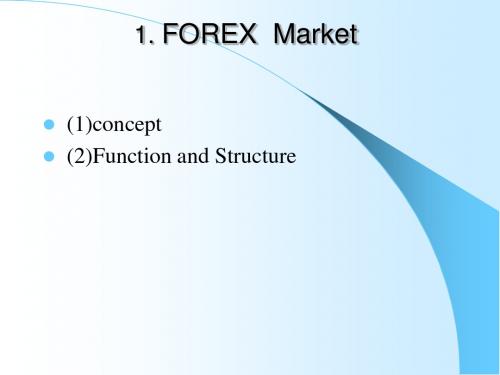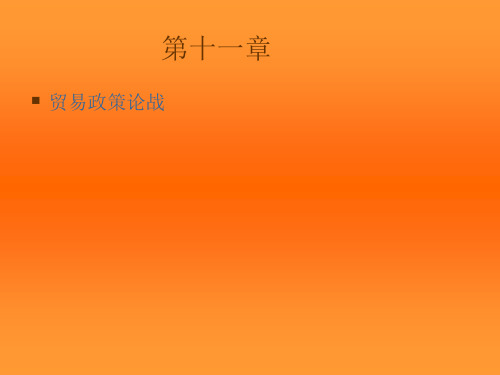国际经济学(第十一章)
- 格式:ppt
- 大小:1.36 MB
- 文档页数:26

十万种考研考证电子书、题库、视频学习平台第11章国际经济非均衡传导11.1 复习笔记一、国际商品交换领域中的传导机制1.加入国际商品交换因素的经济均衡与失衡加入国际商品交换因素,就是指在封闭的宏观经济模型中加入进口和出口两项因素。
国民收入恒等式:=+++Y C I G X=+++Y C S T M经过变换,可得:S I X M−=−。
这一公式的经济含义为,在开放的条件下,若一国的投资与储蓄相等,即储蓄都能有效地转换为投资,要求一国的进口与出口也必须相等。
(1)均衡下的经济增长在S I X M−=−的均衡中:①出口大于进口,但储蓄与投资仍然保持相等,国际收支顺差。
由于出口属于国民收入均衡公式中需求方的一项,于是总需求大于总供给,在其他条件不变的情况下,将产生通货膨胀。
②进口大于出口,但储蓄与投资仍然保持相等,由于进口属于国民收入均衡公式中供给方的一项,于是总供给大于总需求,国际收支出现逆差,经济出现衰退,失业增加。
③进出口变化(汇率、利率、价格、偏好诸因素的任何变化,都必然会导致进出口变化)而产生经济失衡时,可以通过调节投资、储蓄、出口、进口中任何一项,使经济恢复均衡。
十万种考研考证电子书、题库、视频学习平台(2)国际商品交换中的乘数效应一国经济达到了内外均衡,即有S I X M−=−,只是表明经济处于某种状态,它本身并不说明一国经济已经达到了稳定的增长、稳定的物价和充分就业等宏观经济目标。
要达到宏观经济目标,在存在国际商品交换的条件下,人们可以通过进出口来进行调节。
①投资乘数投资乘数分析的是投资与国民收入、就业之间的相互影响、相互制约关系,描述经济体内部投资促进经济增长传导的动态过程。
乘数理论的公式推导过程如下。
从宏观经济学的供给和需求方面可以得到收入的决定公式:=++Y C I G=++Y C S T若G T=,则有:I S=。
其增量为:d d=。
I S变形后为:()I S Y Y=/d d d d()=/d d/d dY I S Y投资乘数的政策含义是:投资会引致收入的成倍增长,因此投资在国民经济中的作用远比投资本身要大得多。


第十一章开放条件下的宏观经济政策一、单项选择题1.在开放经济中,宏观经济政策的主要目标包括经济增长、充分就业、价格稳定和()A.国际收支顺差B.国际收支逆差C.内部均衡D.国际收支平衡2.在开放经济中,宏观经济政策的首要目标是()A.经济增长B.充分就业C.价格稳定D.国际收支平衡3.在宏观调控中,汇率政策的主要问题是()A.确定合理的汇率水平B.确定汇率制度C.确定汇率的标价方法D.确定关键货币4.一国实现内外均衡目标的最主要的政策工具是()A.财政政策与货币政策B.汇率政策C.直接管制政策D.融资政策5.在IS-LM-BP模型中,推动LM曲线右移,使产出增加、利率降低的政策是()A.扩张性的财政政策B.扩张性的货币政策C.紧缩性的财政政策D.紧缩性的货币政策6.在固定汇率制下,扩张性货币政策无效的资本状态是()A.资本不完全流动B.资本完全流动C.资本完全不流动D.不确定7.在固定汇率制下,扩张性财政政策在长期内无效的资本状态是()A.资本不完全流动B.资本完全流动C.资本完全不流动D.不确定8.在固定汇率制下,一国失业和顺差并存时可以采取()A.扩张性的财政政策与货币政策B.紧缩性的财政政策与扩张性的货币政策C.紧缩性的财政政策与货币政策D.扩张性的财政政策与紧缩性的货币政策9.斯旺模型的原理说明当经济处于通货膨胀和国际收支顺差时,应采取的政策是()A.减少国内支出和货币升值的政策B.增加国内支出和货币升值的政策C.减少国内支出和货币贬值的政策D.增加国内支出和货币贬值的政策10.在浮动汇率制和资本完全流动情况下,BP曲线是()A.一条水平线B.一条垂直线C.一条向右上方倾斜的曲线D.难以确定11.在浮动汇率制下,扩张性的货币政策导致利率下降的资本状态是()A.资本不完全流动B.资本完全流动C.资本完全不流动D.不确定12.在浮动汇率制和资本完全流动性情况下,通过扩张性货币政策不会影响()A.收入B.利率C.汇率 D.价格二、判断改错题1.主要通过调节社会需求的内部结构来调控宏观经济的政策工具是需求增减型政策。

冯德连主编《国际经济学(第五版)》关键词、复习与思考答案第十一章发展中国家的贸易政策实践一、关键词1. 发展中国家。
不同的国际组织按照各自不同的标准划分世界各国或地区经济社会发展水平的类别。
在通常意义上,发达国家之外的那些国家都可以被笼统地称为发展中国家,这些国家的人均收入水平较低,经济(尤其是工业经济)和社会发展水平相对落后,面临艰巨的发展任务。
2. 经济发展。
不仅包括经济总量的增长还包括经济质量的提高乃至社会的全面进步。
3. 工业化。
工业产值在国民总产值中的比重提高的过程,在这一过程中,工业吸纳的就业量不断提高,工业发展对国民经济和社会发展的作用不断提高。
4. 初级产品。
不经过人类加工或者只经过较少加工的产品,一般包括资源类产品和农产品。
5. 普雷维什−辛格假说。
20世纪50年代,著名阿根廷经济学家普雷维什和德国经济学家辛格发表的研究认为,发展中国家由于依赖廉价的初级产品出口而使其长期贸易条件恶化了(即每单位出口商品所换回的外国商品数量越来越少了),也就是与大量出口制成品的先进工业国相比,发展中国家因不公平的国际交换更容易陷入收入下降的困境,这对于发展中国家经济增长来说是很不利的。
这一有关发展中国国家贸易条件长期恶化的观点被学界称为“普雷维什-辛格假说”6. 进口替代工业化战略。
政府采用限制竞争产品进口、财政优惠等措施,保护国内进口竞争产业发展的工业化发展战略。
7. 拉美债务危机。
第二次世界大战以后,拉丁美洲地区的部分国家(如阿根廷、智利、巴西等)由于长期推行进口替代工业化战略,举借大量外债购买国外资本品。
20世纪70年代末至80年代初,受石油等初级产品价格波动影响,拉美部分国家无法偿付到期外债,债务危机爆发。
8. 出口导向工业化战略。
发展中国家和地区以发挥比较优势为基础,推进资源密集型和劳动密集型产品出口,并以此加速收入积累,提升工业化水平的战略。
二、复习与思考1. 什么是经济发展?联合国《2030年可持续发展议程》设立的发展目标包括哪些?第十一章发展中国家的贸易政策实践答:经济发展不仅包括经济总量的增长还包括经济质量的提高乃至社会的全面进步。


CHAPTER 11INTERNATIONAL TRADE AND ECONOMIC DEVELOPMENTOUTLINE11.1 Introduction11.2 The Importance of Trade to Development11.2a Trade Theory and Economic Development11.2b Trade as an Engine of Growth11.2c. The Contributions of Trade to Development11.2d. International Trade and Endogenous Growth Theory11.3 The Terms of Trade and Economic Development11.3a The Various Terms of TradeCase Study 11-1: The East Asian Miracle of Growth and TradeCase Study 11-2: The Crisis in High-Performance Asian Economies (HPAEs)11.3b Alleged Reasons for Deterioration in the Commodity Terms of Trade11.3c Historical Movement in the Commodity and Income Terms of Trade 11.4 Export Instability and Economic Development11.4a Causes and Effects of Export InstabilityCase Study 11-3: Change in Commodity Prices Over Time11.4b Measurements of Export Instability and its Effect on Development11.4c International Commodity Agreements11.5 Import Substitution versus Export Orientation11.5a Development Through Import Substitution Versus Exports11.5b The Experience with Import SubstitutionCase Study 11-4: The Growth of Rich Countries, Globalizers and Non-Globalizers11.5c Recent Trade Liberalization and Growth in Developing CountriesCase Study 11-5: Manufactures in Total Exports of Selected DevelopingCountries11.6 Current Problems Facing Developing Countries11.6a Poverty in Developing Countries11.6b The Foreign Debt Problem of Developing CountriesCase Study 11-6: The Foreign Debt Burden of Developing Countries11.6c Trade Problems of Developing CountriesCase Study 11-7: Globalization and World PovertyAppendix: Income Inequalities by Traditional and Purchasing-Power Parity (PPP) Measures Key TermsRegions of recent settlement Buffer stocksEngine of growth Export controlsVent for surplus Purchase contractsEndogenous growth theory Import substitution industrialization (ISI) High-performanceAsian economies (HPAEs) Export-oriented industrialization Commodity, or net barter, terms of trade Foreign debtIncome terms of trade Newly industrialized economies (NIEs) Single factoral terms of trade Export pessimismDouble factoral terms of trade New International Economic order (NIEO) Export instability United Nations Conference on Trade and Marketing boards Development (UNCTAD)International commodity agreementsLecture Guide:1. This is not a core chapter and I would skip it, except for section 6.2. If I covered this chapter, I would present two sections in each of three lectures.Answer to Problems:1. International trade could retard development by:∙keeping the nation in primary production;∙leading the nation to adopt excessive capital-intensive production techniques;∙increasing the propensity to consume, thus reducing the nation's savings rate;∙leading to foreign exploitation of natural resources;2. Each of the criticisms that international trade can retard development given in theanswer to problem 1 can by countered as follows:∙As the availability of capital and technology increases, the nation can begin to export manufactured goods;∙through appropriate taxes and subsidies the nation can avoid the use of excessive capital-intensive production techniques;∙increased taxation can increase the rate of public savings;∙taxation and regulation can reduce or eliminate foreign exploitation;3. An improvement in the technology of primary production results in a shift in the nation'stransformation curve from Y1X1 to Y1X2 in Figure 1.4. An improvement in the technology of primary production is likely to lead to deteriorationin the terms of trade as the developing nation exports more primary commodities.5. A vent for surplus can be shown by a movement from point A inside the nation'sproduction frontier without trade to point A' on the higher production frontier withgrowth and trade in Figure 2 on the previous page.6. a) The nation's commodity terms of trade would be 91.7.b) The nation's income terms of trade would be 119.2.c) The nation's single factoral terms of trade would be 128.4.7. The nation of problem 6 will be better off in 2000 as compared with 1980 because itsincome and single factoral terms of trade rose.8. Figure 7-6 in the text shows how deteriorating terms of trade resulting from growth canmake a nation worse off after trade than before. This was called immiserizing growth in Chapter 7.9. Figure 3 on the previous page shows that when the supply of a commodity increases, itsequilibrium price will fall by a greater amount, the more price inelastic is the demandcurve for the commodity.10. Figure 4 on the next page shows that with a negatively inclined demand curve and apositively inclined supply curve, producers' earnings fluctuate more with a shift indemand (Panel a) than with a shift in supply (Panel b).11. Figure 5 shows how a buffer stock could either lead to an unmanageable stock of thecommodity or to the running out of the commodity. Specifically, if the buffer stockauthority sets price above the long-run equilibrium price of the commodity, it will facean unmanageable stock of the commodity. On the other hand, if the buffer stockauthority sets price below the long-run equilibrium level, then the buffer stock authority will run out of the commodity.12. A New International Economic Order (NIEO) has not been established because industrialcountries did not want to give up control over the present system and pay the economiccosts of reforming it along the lines demanded by developing countries. Theestablishment of a NIEO is no longer a hotly debated topic because developed countries faced serious problems of their own during the 1980s and early 1990s in the form of slow growth and high unemployment. The NIEO was replaced by concerns about globalization in the 1990s.13. The Uruguay Round benefited developing countries by the reduction in tradeprotectionism on agricultural products and labor-intensive commodities. Althoughprotectionism will be reduced, it will still remain relatively high in these products. (6920833.doc) 11-4 Dominick Salvatore14. Immiserizing growth does not seem to have occurred in most globalizing developingcountries despite some deterioration in their terms of trade because the volume of trade and their income terms of trade have increased substantially over the past three decades.15. Rich nations should forgive all of the foreign debt of the poorest developing countriesbecause it is impossible for them to repay it or even service it. This, however, mightencourage the poorest nations to continue to borrow and even use borrowed fundsunwisely knowing that eventually their foreign debt might be forgiven.(6920833.doc) 11-5 Dominick Salvatore(6920833.doc) 11-6Dominick SalvatoreMultiple-choice Questions:1. According to traditional trade theory, a developing nation should export the commodity:a. of its comparative advantageb. that it can produce relatively more efficientlyc. intensive in the nation's relatively abundant factor*d. all of the above2. Which of the following is false with respect to traditional trade theory?a. it can incorporate changes in factor endowments and technologyb. it leads to the best allocation of resources at any point in time*c. it is a dynamic theoryd. it is based on comparative advantage3. According to Nurkse, international trade was an engine of growth for:*a. the regions of recent settlements during the 19th centuryb. regions of recent settlements during the 20th centuryc. developed nations during the 19th centuryd. developed nations during the 20th century4. Trade cannot be an engine of growth for today's developing nations because:a. the income elasticity for many of their exports is less than 1b. the development of synthetic substitutesc. technical advances reduced the raw-material content of many products*d. all of the above5. If the price of a nation's exports and imports both rise, the nation's commodity terms oftrade:a. improveb. deterioratec. remain unchanged*d. any of the above6. The nation's commodity terms of trade times the productivity index in its export sectorgives the nation'sa. income terms of trade(6920833.doc) 11-7 Dominick Salvatoreb. double factoral terms of trade*c. single factoral terms of traded. barter terms of trade7. When a nation's commodity terms of trade deteriorate and its single factoral terms oftrade improve, the nation's welfare:a. falls*b. risesc. remains unchangedd. any of the above9. Developing nations often experience wildly fluctuating export prices for their primary products because of:a. inelastic and stable demand and supplyb. elastic and unstable demand and supply*c. inelastic and unstable demand and supplyd. elastic and stable demand and supply10. MacBean found that the export instability faced by developing nations was:*a. not very large and did not seriously interfere with developmentb. very large and seriously interfered with developmentc. very large but did not seriously interfere with developmentd. not very large but seriously interfered with development11. Supporting the price of a commodity by buying it when its price is low is:*a. a buffer stockb. a purchase contractc. an export controld. a marketing board12. The policy of import substitution was most vigorously followed by:a. large developing nations during the 1970's*b. large developing nations during the 1960'sc. small developing nations during the 1970'sd. small developing nations during the 1960's13. What is the advantage of a policy of import substitution?(6920833.doc) 11-8 Dominick Salvatorea. setting up an industry to replace imports minimizes risk of failure because the market for the product already exists in the nation as evidenced by the nation's imports of the commodityb. It is easier for developing nations to protect their domestic market against foreign competition than to force developed nations to lower their trade barriers against their manufactured exportsc. foreign firms are induced to establish tariff factories to overcome the tariff wall of developing nations*d. all of the above.14. Which are is not an advantage of export-oriented industrialization?a. It overcomes the smallness of the domestic market and allows developing nations to take advantage of economies of scale*b. domestic industries grow accustomed to protection and have an incentive to become more efficientc. production of manufactured goods for export requires and stimulates efficiency throughout the economyd. the expansion of manufactured exports is not limited by the size of the domestic market15. Those nations that liberalized trade during the past decade*a. grew faster than those that did notb. grew more slowly than those that did notc. grew at about the same rate as those that did notd. any of the above16. Which of the following is not part of the demand for a NIEO?a. the establishment of international commodity agreements*b. preferential access for the manufactured exports of developed nationsc. removal of the agricultural trade barriers in developed nationsd. increasing the yearly flow of foreign aid to developing nations(6920833.doc) 11-9 Dominick Salvatore。